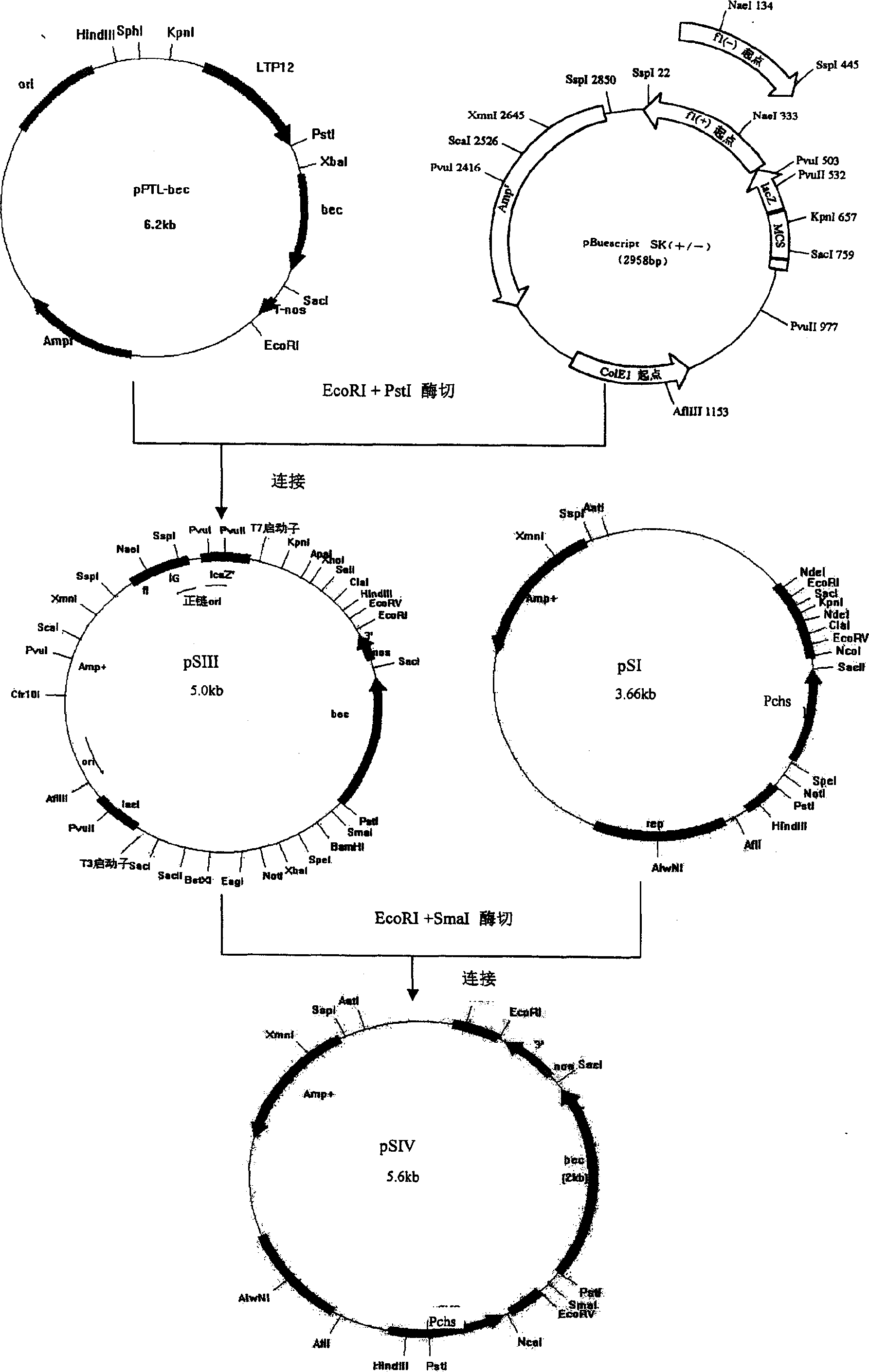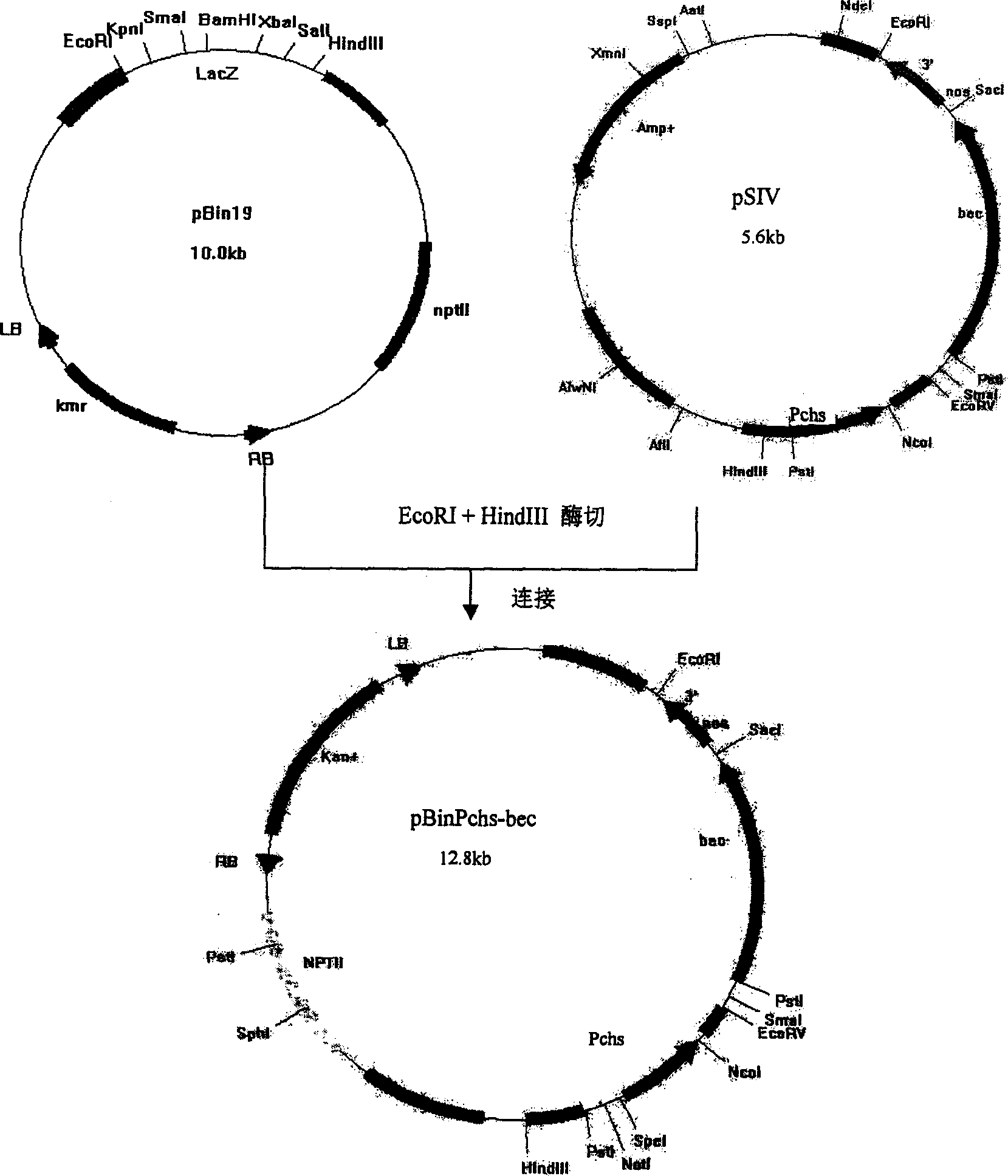Specific expression carrier of bec gene in floral organ
A technology for expressing vectors and flower organs, which is applied in genetic engineering, plant genetic improvement, and the introduction of foreign genetic material using vectors, etc. It can solve the problems of low yield and complicated extraction process, and achieve the effect of changing color and improving ornamental value
- Summary
- Abstract
- Description
- Claims
- Application Information
AI Technical Summary
Problems solved by technology
Method used
Image
Examples
Embodiment 1
[0018] Example 1: Extraction of Arabidopsis total DNA.
[0019] 1. Take Arabidopsis thaliana Columbia ecotype seeds, inoculate them on the culture medium after aseptic treatment, and wait for the leaves to grow.
[0020] 2. Weigh 4 grams of fresh leaves as plant material, grind them into powder in liquid nitrogen, put them into a 50ml centrifuge tube, add 20ml of ice-bathed extraction buffer, and mix well.
[0021] 3. Centrifuge at 2,700g for 20 minutes, take the supernatant and add 8ml of lysis buffer, vortex to mix well, and incubate at 65oC for 20-30 minutes.
[0022] 4. Add 10 ml of chloroform / isoamyl alcohol (24:1), invert and mix well, centrifuge at 12000 rpm for 5 minutes, take the upper phase and transfer it to a new centrifuge tube. Repeat this several times until the interface is clear.
[0023] 5. Pipette the upper phase into another new Eppendof tube, add 2 / 3 volume of ice-cold isopropanol (about 5.6ml), and let stand at room temperature for 20-30 minutes.
[00...
Embodiment 2
[0030] Example 2: Cloning of a floral organ-specific promoter.
[0031] 1. Floral organ-specific promoter Pchs primers.
[0032] Upstream primer 5'-TAG GAG TTA AGT ATG CAC GTG TAA GAA CT-3'
[0033] Downstream primer 5'-CGC TAT AGT TAT CAC CAA CTT GG-3'.
[0034] 2. PCR amplification: The high-fidelity PCR reaction system is as follows: 10×ExBuf (Mg2+free) 2μl; 2mM dNTPMixer 2μl; 25mM Mg 2+ 1 μl; 0.2 μl of ExTaq DNA Polymerase, ie 1u; 1 μl of upstream primer, 30 pmol; 1 μl of downstream primer, 30 pmol; 1 μl of template (Arabidopsis total DNA about 10-250ng), add sterile ddH2O to make up 20 μl. Reaction program: pre-denaturation at 94°C for 3 minutes - (94°C for 40 seconds - 55°C for 30 seconds - 72°C for 40 seconds) × 35 cycles - 72°C for 10 minutes.
[0035] 3. After the reaction is completed, take 10 μl of the sample and go through 1.0% agarose gel electrophoresis, carefully cut out the specific fragment at about 530 bp with a disposable blade under ultraviolet light, re...
Embodiment 3
[0037] Example 3: Construction of floral organ-specific promoter gus expression vector (pESII).
[0038] 1. Take 7 μl of the PCR recovered product and connect it with 1 μl pGEM-T vector, transform Escherichia coli DH5α, and sequence and identify pGEM-T-Pchs.
[0039] 2. Digest pGEM-T-Pchs with PstI and NcoI, and connect the resulting fragment to the pUC-T-GAFP vector fragment that has been digested with PstI and NcoI, transform and identify, and obtain the intermediate vector pSI.
[0040] 3. The size of the positive clone was identified by double enzyme digestion with PstI and NcoI, and a fragment with a size of about 0.54 KB was excised.
[0041] 4. The Pchs promoter fragment obtained by digesting the intermediate vector pSI with HindIII and EcoRV was connected to the pBI121 vector fragment digested with HindIII and SmaI to obtain the floral organ-specific promoter gus expression vector pES II. Positive clones were identified by PCR, and a band of about 0.53 kb was seen, wh...
PUM
 Login to View More
Login to View More Abstract
Description
Claims
Application Information
 Login to View More
Login to View More - R&D
- Intellectual Property
- Life Sciences
- Materials
- Tech Scout
- Unparalleled Data Quality
- Higher Quality Content
- 60% Fewer Hallucinations
Browse by: Latest US Patents, China's latest patents, Technical Efficacy Thesaurus, Application Domain, Technology Topic, Popular Technical Reports.
© 2025 PatSnap. All rights reserved.Legal|Privacy policy|Modern Slavery Act Transparency Statement|Sitemap|About US| Contact US: help@patsnap.com


